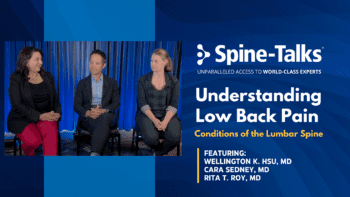EVERYONE’S DISCS AGE; HOWEVER, THE PAIN PATTERN CAN DIFFER GREATLY BETWEEN PATIENTS.
As part of the normal aging process, progressive changes develop in the discs that cushion each vertebra. These changes, termed degenerative disc disease, lead to loss of disc height, loss of water content, loss of the shock absorbing capacity of the disc, and bone spur formation. In some patients, there is very little discomfort and only a feeling of progressive stiffness, while in others, pain is the dominant symptom, occurring in the neck and/or back.
CAUSES
Although disc degeneration appears to be an aging phenomenon, different experts believe that the discs have various pain patterns secondary to inflammation. This inflammation causes the irritation of the nerve endings that enter the annulus fibrosus (outer layer of the disc). The body tries to deal with the inflammation by forming scar tissue in the area. Over time, the progressive loss of height causes friction between the vertebrae. Bone spurs then form at the front and back of the vertebral bodies with the goal of actually forming bone to bridge across the disc space, increasing pain.
SYMPTOMS
In the low back, pain likely radiates horizontally across the low back and is exacerbated by prolonged sitting or standing. Many patients find pain relief when they are lying down or reclining.
In the neck, pain likely radiates from the neck out toward the shoulders, typically worsening over the course of the day and relieved by lying down.
DIAGNOSIS
MRI scans often identify the extent of degenerative disc disease in either the neck or the low back and procedures such as discography can be performed in an attempt to identify specific pain generators.
TREATMENT
There are a number of treatment options for degenerative disc disease, whether it be in the neck or low back. A combination of anti-inflammatories and physical therapy is often all that is necessary to relieve neck or low back pain. There may be some value to manual physical therapy and chiropractic manipulation. If needed, stronger pain medications can be used and corticosteroid injections can be performed. For patients whose pain becomes unmanageable by all of these interventions, surgery becomes a real option.



